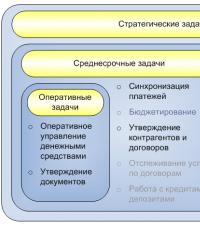An unusual recipe for mamaliga in Georgian style. Georgian corn porridge - mamaliga Recipe for making porridge with cheese in Georgian style
Mamaliga, as you know, is the name given to traditional Georgian thick corn porridge. By the way, in some regions of Georgia it is still used as bread. Initially, hominy was prepared from Italian millet (millet). This dish is eaten and prepared with pleasure in other countries, for example, in Romania and Moldova. The very name of porridge comes from their language, but Georgians call mamalyga - gomi.
Mamalyga is an inexpensive, healthy and easy-to-prepare dish. You can add dishes such as lobio or Georgian chicken liver to the mamaliga. In this case, you will also receive an inexpensive but very tasty menu.
Many years ago, Georgians cooked millet mamaligu. However, they used an unusual millet, but an Italian one. And then corn replaced it. In the 1940s, not only millet, but also corn began to be sown in Georgia.
In Russia, mamalyga was made from millet until corn flour became available for free sale. It is worth noting that it does not taste the same as in Georgia.
If you prefer millet hominy, it is better to immediately fry it with cheese.
Ingredients:
- corn grits – 1 part;
- water – 3.5 parts (for example, if you take 2 cups of cereal, then you need 7 cups of water);
- cheese (suluguni or other).
Cooking method
 Georgians cook mamaliga from white corn grits according to the recipe. It has a slightly different taste than the regular one. For example, we take 5 glasses of corn grits (that’s 650 grams, that’s enough for about 5-6 servings) and 17 glasses of water. Depending on the grain and fire, you may need more water. Initially, use the rule: less water is better than more. After all, when the cereal boils, you can add water to it if necessary. But if there is too much water, you will have to evaporate it for a long time.
Georgians cook mamaliga from white corn grits according to the recipe. It has a slightly different taste than the regular one. For example, we take 5 glasses of corn grits (that’s 650 grams, that’s enough for about 5-6 servings) and 17 glasses of water. Depending on the grain and fire, you may need more water. Initially, use the rule: less water is better than more. After all, when the cereal boils, you can add water to it if necessary. But if there is too much water, you will have to evaporate it for a long time.
Information for lovers of salty foods: after cooking, hominy should not be eaten salted. You can only slightly salt the water at the very beginning of cooking. Many people prefer not to add salt at all. After all, the cheese in this dish should be salty.
So, we poured water over the cereal and put it on low heat. Cook the porridge over low heat until the water boils away. Try mamalyga; if the cereal is boiled, then the porridge is ready. Everything is very simple!
The cooking time for this dish according to the recipe will depend on the intensity of the fire, the size of the cereal and the quality of the cereal. In this regard, the cooking time varies from 45 minutes to 1.5 hours. In the above proportions, the porridge is cooked for 1 hour and 15 minutes.
You can choose the thickness of the porridge depending on your preferences. But remember that hominy should not be liquid. It should not flow, like, for example, rice milk porridge. When laying hominy on plates, it should form a non-spreading mound.
After boiling, the hominy must be stirred, otherwise there is a risk of lumps forming. And during further cooking, the upper layers of the porridge will not receive enough heat compared to the lower ones.
To make it easier to mix hominy, it is better to use a wooden spatula called chogani. In general, you can use any spatula, which one you have at home. The main condition: it should not be too thin, otherwise it may break.
There is an opinion that this porridge needs to be supplemented with corn flour, or if it is not available, then semolina. Let's figure it out. The purpose of adding flour is to thicken the mixture. This is necessary if you purchased large grains. However, the factory-made cereal that you find on store shelves is usually small, so you don’t need to add flour, the porridge will already be thick.
Corn crunches
 After cooking the porridge, you can make another dish - corn crunches. This is also a simple, uncomplicated, but very tasty dish.
After cooking the porridge, you can make another dish - corn crunches. This is also a simple, uncomplicated, but very tasty dish.
After you put the finished porridge on plates, there is still a lot of hominy left on the walls of the pan. Place this pan on low heat. The porridge on the walls will dry out, fry and turn into crispy tasty crust. Your crunchies are ready! They easily break off from the walls of the pan. Children love these crunches very much.
How to serve hominy
As we have already said, hominy needs to be placed in a heap on a plate. We insert pieces of cheese into the slide - suluguni or imeruli. Mamalyga is applied with a chogani spatula. To prevent the porridge from sticking to the spatula, the chogani should be periodically moistened in cold water.
There is no need to cook hominy for several days. Everything prepared according to the recipe should be eaten immediately. Do not store hominy in a pan. And if there is any left, fry it. Mamalyga is served and eat while it's hot.
Cheeses
Factory-made suluguni, although it is a poor copy of real suluguni, is still suitable for us to add to porridge. You can use feta cheese, Adyghe cheese and other types of cheese. The main condition is that the cheese melts and is salty. Many people believe that Western European cheeses do not go well with hominy. By the way, try adding salted cottage cheese or cottage cheese with mint and adjika to the mamalyga.
What do you eat this porridge with?
 As we have already mentioned, in some regions of Georgia, mamaliga is used as a substitute for bread. In this regard, it is eaten with almost all dishes.
As we have already mentioned, in some regions of Georgia, mamaliga is used as a substitute for bread. In this regard, it is eaten with almost all dishes.
Porridge goes well with lobio or fried pork. The gravy for the porridge can be tkemali, tomato satsebeli, for example, made from the right tomato paste, and adjika with sour cream.
You can come up with nothing and eat this porridge without anything. If you have any left, fry the porridge with cheese and eggs.
Usually the porridge is fried in a frying pan with cheese. For some, this is the preferred cooking method.
Georgian step-by-step recipe for GOMI - a popular dish from Samegrelo, which is prepared from coarse corn flour. In appearance and consistency, gomi resembles porridge. This is a very tasty dish with slices of suluguni cheese and butter, which is prepared in all Georgian families. See another similar recipe -.
Ingredients
- 200 g coarse corn flour,
- 4 tbsp. finely ground corn flour,
- 400 g suluguni cheese (can be replaced with Imeretian cheese or mozzarella),
- 40 g butter,
- 1.5 liters of water (milk),
- 1 tsp salt.

Preparation
Add cornmeal and salt to a deep cast iron skillet.

Pour in water, mix thoroughly, put on fire and cook over low heat, stirring frequently, for 20-25 minutes.

After 20-25 minutes add 4 tbsp. spoons of finely ground corn flour. Cook over low heat, stirring vigorously continuously, for 5-7 minutes. The finished gomi should look like the photo below.

Pour hot gomi into plates, add chopped cheese and butter. Many people like to eat gomi with nut sauce
Gomi- This is a variant of mamalyga, which is cooked without salt. Gomi is served instead of bread with satsivi, kharcho with nuts, bazhi, etc. Gomi is served hot or warm on a separate plate. With a fork you need to take a small piece of gomi and dip it well in kharcho (satsivi or bazhi), even scoop it up.
You can also put very hot gomi on plates and stick pieces of suluguni (mazzarella) into it - it will be a very tasty dish. This gomi can also be served as an independent dish, but it must be eaten while it is still hot.
Coarsely ground corn is called "Gergili". Those who cannot get such corn can use broken (coarsely chopped) round rice instead. Of course, the taste of the dish will change a little, but it will still be very tasty.
Ingredients:
- 1 cup (full) coarsely ground corn,
- 4 tbsp. corn flour,
- 4 glasses of water.
How to cook:
- Coarsely ground corn must be thoroughly cleaned of small husks that were poorly ground during coarse grinding. The husk then spoils the taste of the dish, since it does not boil down.
- Coarsely ground corn should be placed in a deep bowl and filled with water. Stir with your hand and carefully drain the water, and the husks should be drained along with the water. Then add water again and repeat the same thing. You need to rinse until the water becomes clear and there are no husks left. You will immediately see how the cereal has been cleaned.
- Pour water into a cast iron pan, add coarsely ground corn and, when it boils, reduce the heat.
- Cook over low heat (preferably on a divider) until it is boiled.
- Then add corn flour - stir quickly so that lumps do not form and it does not burn. Continue cooking and stirring until the gomi thickens and the flour loses the taste of raw flour.
- The finished gomi should pull away from the sides of the pan.
- Gomi should be immediately placed on plates while it is still very hot.
Gomi is corn porridge. In the old days it was prepared from chumiza. And since the end of the 19th century, corn has replaced chumiza. Gomi is prepared mainly in the rural areas of the Caucasus and is also considered a poor man's food.
Gomi is a type of hominy. An analogue of this dish is prepared in the Carpathians, Moldova, and Romania. In difficult times, gomi can even replace bread. This dish is cut with a knife or waxed thread. It’s no secret that not everyone likes gomi, even in Georgia, but there are true connoisseurs of this dish all over the world. Try it, maybe you'll like it. Bookmark the recipe so you don't lose it.
Gomi recipe ingredients
| Name | Quantity | Unit |
| Corn flour | 1.00 | cup |
| Corn grits | 2.00 | cup |
| Water | 6.00 | cup |
| Salt | taste |
Cooking Gomi
Wash the cereal in warm water.

Add water to the cereal and put the saucepan with the cereal on the fire.

When the porridge has thickened and cooked, add flour. Cook until a viscous homogeneous mass is obtained. If the gomi does not smell of flour, then the dish is being cooked.

Pour the crushed corn into a sieve, place in a bowl of cold water so that the sieve fits completely and the water freely covers the contents. Stirring with your hand in a circle, rinse thoroughly under running water - try to make the black particles of the grains float up and drain them, continuing the process until complete “bleaching”.
Place the cereal in a thick-walled saucepan or cauldron, pour in 1.5 liters of cold water, and place over high heat. After boiling, skim off the foam with the remaining grain particles, reduce the heat, stir with a wooden spatula or spoon, reaching to the very bottom, and continue cooking.
During the cooking process, the cereal forms a viscous, homogeneous mass, which must be thoroughly mixed from time to time to the very bottom.
After 40 min. Gradually add the sifted corn flour into the gomi, stirring at the same time, so that no lumps form. Cover with a lid and let simmer for 15 minutes. – the smell of flour should disappear. Readiness can be determined by the fact that the edges of the gomi near the walls of the pan begin to dry out, forming a film.
The gomi can be placed on a common deep dish and put slices of suluguni inside, or it can be placed on portioned plates: dip a spatula in cold water, scoop up the gomi and place it on a plate. Place each guest’s portion next to the main appliance, and be sure to have it very hot so that the suluguni has time to melt.




